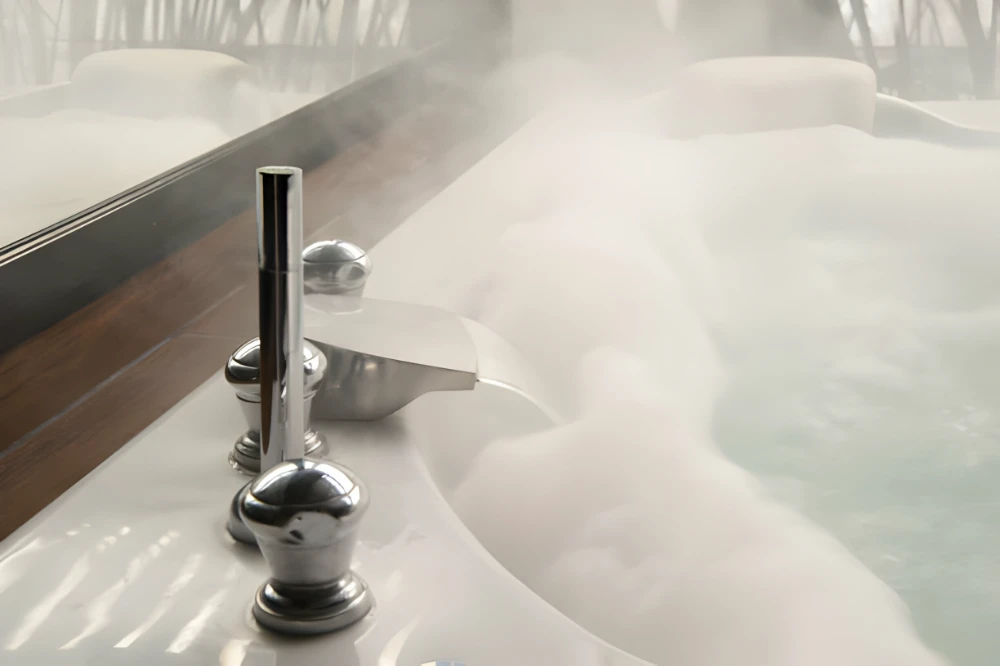A gray to green to yellow liquid could come out of your plumbing. That’s a sign of a foreign substance in your water.
However, you don’t necessarily need to worry about this strange color. After all, your tap could produce this oddly colored liquid for a myriad of reasons. Nevertheless, you should know why hot water is cloudy to avoid contaminated liquids.
In this blog, you’ll discover the significance of the appearance of water. Additionally, you’ll explore the methods to make this liquid drinkable and safe to use.
Why Is My Hot Water Cloudy?

Here’s what causes changes in color:
Air Dissolves in the System
This is a common reason why streams come out cloudy. More specifically, air enters your system. Then, it dissolves since it’s under high pressure from the heat. When the liquid comes out, the air bubbles make it look white or gray.
However, once it’s left on the tap, it depressurizes. And so, the air escapes into the surroundings. To check that this is the reason why your hot water is cloudy, pour some water into a glass and wait five minutes. If the liquid clears up starting from the bottom of the glass, you’ll know that it’s just air.
Hard Water Has Minerals
This type of water has a large ratio of minerals such as aluminum or manganese. If you pour some of this water into a glass, it might clear up like dissolved air. However, that’s not the only result you might get with hard water:
- Clears Up: It’s possible that among the minerals in your water, there’s calcium bi-carbonate. When your system heats water, the molecule turns into carbon dioxide. Since the pressure is high, the gas dissolves in the water. However, after water comes out of the tap it’ll escape into the surroundings like air.
- Stays Cloudy: Your water will remain a grayish or white color if there’s a high mineral concentration. You can add a water softener to your system. The water should then run clear.
- Particulate Settle: The substance that drifts down in your glass could be a mineral build-up. For that, you should use a water softener. However, until your water is clear you shouldn’t drink it.
Your Aerator Is Dirty
At the end of your tap, there’s this metal mesh. An aerator regulates your water stream. When it’s clogged it can cause cloudy hot water. If your water only comes out with this odd color from one tap, the aerator could have an obstruction.
You can determine if your clogged aerator is at fault by cleaning it. You should use a solution that’s equal parts water and vinegar and let the aerator soak in it for at least a day.
The next morning, you should rinse it and reinstall it. Then, check if the water is still cloudy. If it’s not clear or regains this off-color after some time, you should replace your aerator.
Your Hot Water System Malfunctioned
If your water heater has an issue such as a broken part, it could affect the quality of your water. Therefore, you should call a professional to test your system. A plumber will identify the problem area and replace the parts needed. Then, your water will come out of the tap clear.
Your Water Service Interrupted the Main Supply
If the organization that sources your water is working on the plumbing lines, they’ll shut off the service. While the water is off, air enters the plumbing system. And so, it dissolves into your water and gives it that cloudy appearance. Unlike with air dissolving due to pressure, this offers both cold and hot water a cloudy look.
Just like when air dissolves at high pressure, it’ll return to the air if you pour some water into a glass. You can also call your water provider to find out if they’re currently working on the plumbing in your area. If they’ve shut off the water, you should wait until it’s back on to test your water again. The water will return to normal at some point within the next few weeks.
There Are Contaminants
As your water flows from its source to your tap, it could pick up materials such as:
- Bacteria: Your water may be cloudy with a yellow, green, or brown tint. You should hire a plumber to test your water to ensure its safety. Meanwhile, you should install a filtration system to make it safe to use.
- Metals: As your water travels through plumbing, some metallic compounds can enter it. Just as with bacteria, you can mitigate this with a filtration system. However, you should hire a plumber to test your water and identify the source of the problem.
Is Cloudy Hot Water Safe?

Now that you’ve identified the reason why your water has this strange color, is it safe? If the cloudiness comes from air or carbon dioxide dissolving into your water, it’s safe. However, if the color is anything but white or gray, it could be harmful contaminants. While you should have your water tested and the issue resolved, the water should be safe to use with a filtration system.
As for hard water, it’s safe to drink. However, the high mineral concentration could damage your hair, clothes, appliances, and plumbing. Hard water reduces the life expectancy of your plumbing and appliances such as dishwashers.
Conclusion
Now you know why cloudy hot water occurs. A common reason is air or carbon dioxide dissolving into your water. If this happens, your water’s safe to use therefore you’re not required to take action. However, the cloudy appearance could be due to natural causes such as minerals in water. You can remedy this by putting a water softener in your system. Or it could be a technical issue from a broken hot water system, repairs in your plumbing, or a clogged aerator. If the issue comes from a part of your plumbing, replacing it should turn your water clear.




